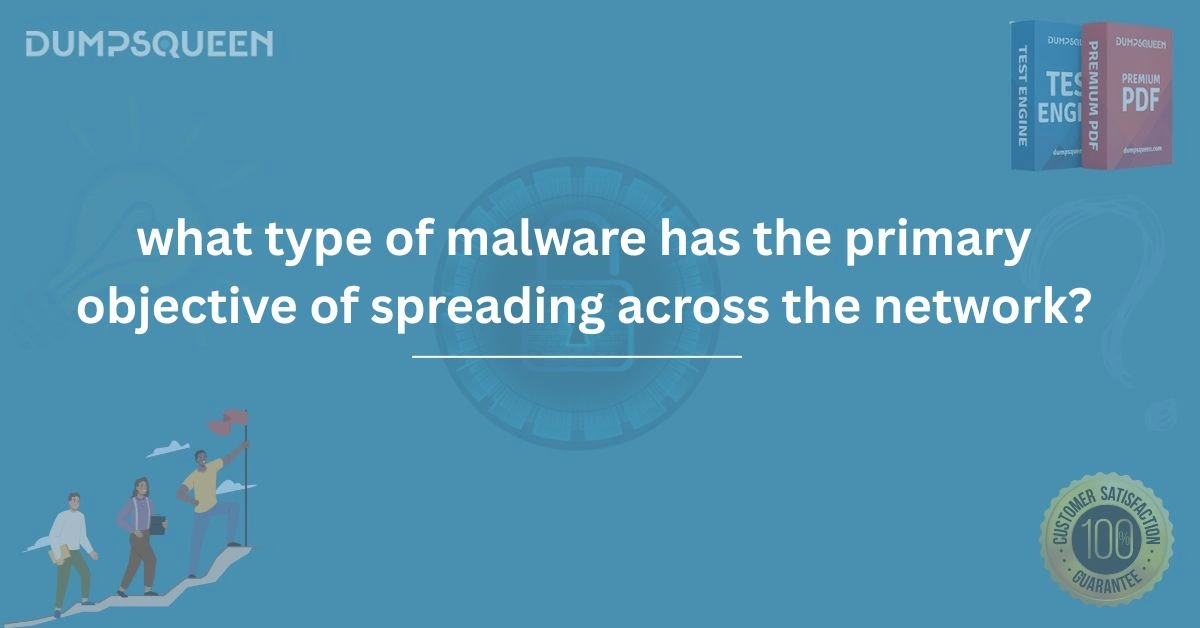Understanding Malware in Cybersecurity: A Deep Dive into Worm Malware and Its Relevance to the Cisco 200-201 Exam with DumpsQueen
Cybersecurity is an ever-evolving field where threats lurk around every digital corner. Among these threats, malware stands out as a pervasive and dangerous adversary. Malware, short for malicious software, encompasses a broad range of programs designed to harm, exploit, or disrupt systems, networks, and users. For anyone preparing for the Cisco 200-201 exam (Understanding Cisco Cybersecurity Operations Fundamentals, or CBROPS), a solid grasp of malware types, including worms, is essential. In this blog, we’ll explore a specific exam-style question about malware, provide the answer, and dive deep into worm malware—its characteristics, comparisons with other malware types, famous examples, and defenses. We’ll also highlight why this knowledge is critical for the Cisco 200-201 exam and how DumpsQueen can be your ultimate resource for success.
Brief Overview of Malware in Cybersecurity
Malware is the backbone of many cyber threats, ranging from data theft to system disruption. It includes viruses, trojans, ransomware, spyware, adware, and worms, each with unique behaviors and goals. In cybersecurity, understanding these threats is crucial for protecting networks and responding to incidents—core skills tested in the Cisco 200-201 exam. Malware often exploits vulnerabilities in software, human error, or misconfigured systems, making it a constant challenge for security professionals. As organizations increasingly rely on digital infrastructure, the ability to identify, analyze, and mitigate malware becomes a foundational skill, especially for those pursuing certifications like the Cisco Certified CyberOps Associate.
A worm is a type of malware distinguished by its ability to self-replicate and propagate across networks autonomously, without needing a host file or user action to spread. This sets it apart from other options like trojans (which disguise themselves as legitimate software), viruses (which attach to host files), and spyware (which focuses on data theft).
Explanation of Worm Malware
Worms are a fascinating and dangerous subset of malware. Unlike viruses, which require a host program to latch onto, worms are standalone programs capable of executing independently. Their defining feature is self-replication: once a worm infects a system, it duplicates itself and seeks out other vulnerable devices to infect, often exploiting network vulnerabilities or weak security configurations. This autonomous spread makes worms particularly destructive in networked environments, where they can rapidly compromise multiple systems.
Worms typically don’t need user interaction—such as opening an email attachment or downloading a file—to propagate. Instead, they exploit software flaws, misconfigured settings, or open ports. For example, a worm might scan a network for systems running outdated software with known vulnerabilities, then use those entry points to infiltrate and spread. This behavior aligns with the Cisco 200-201 exam’s focus on network intrusion analysis and security monitoring, where recognizing worm activity is key to incident response.
Comparison with Other Malware Types
To fully appreciate worms, let’s compare them with other common malware types:
- Viruses: Viruses attach to legitimate files or programs and require user action (e.g., executing an infected file) to spread. Unlike worms, they aren’t standalone and can’t propagate without a host. Their damage often comes from corrupting or deleting data on the infected system.
- Trojans: Trojans masquerade as benign software to trick users into installing them. They don’t self-replicate like worms; instead, they rely on social engineering. Once activated, trojans might install backdoors, steal data, or enable remote control by attackers.
- Ransomware: This malware encrypts a victim’s data and demands payment for decryption. While some ransomware (like WannaCry) incorporates worm-like spreading mechanisms, its primary goal is financial gain, not network propagation.
- Spyware: Designed to covertly collect information (e.g., passwords or browsing habits), spyware prioritizes stealth over replication. It doesn’t spread like a worm but focuses on espionage.
Worms stand out for their autonomy and network-centric behavior, making them a unique threat in cybersecurity operations—a topic heavily emphasized in the Cisco 200-201 exam.
Examples of Famous Worms
History offers several infamous examples of worms that underscore their destructive potential:
1) Morris Worm (1988): One of the first widely recognized worms, created by Robert Morris, exploited vulnerabilities in UNIX systems. It infected thousands of computers, slowing the early internet to a crawl. Though not maliciously intended, it highlighted the dangers of self-replicating malware.
2) ILOVEYOU Worm (2000): Disguised as a love letter email attachment, this worm spread rapidly by exploiting scripting vulnerabilities in Microsoft Outlook. It overwrote files and infected over 50 million systems within days, causing billions in damages.
3) Conficker (2008): Targeting Windows systems, Conficker exploited a network service vulnerability to spread across millions of devices. It created botnets for potential attacks, demonstrating worms’ ability to scale globally.
4) WannaCry (2017): While primarily ransomware, WannaCry used a worm-like mechanism (EternalBlue exploit) to propagate across networks, affecting over 200,000 systems worldwide. It crippled hospitals, businesses, and governments, emphasizing worms’ real-world impact.
These examples illustrate why understanding worms is vital for the Cisco 200-201 exam—professionals must recognize their signatures and respond effectively to mitigate damage.
Defense Against Worms
Defending against worms requires a multi-layered approach, aligning with the defense-in-depth strategy tested in the Cisco 200-201 exam:
- Patch Management: Regularly update software and operating systems to close vulnerabilities worms exploit, as seen with WannaCry’s reliance on unpatched Windows systems.
- Network Segmentation: Limit worm spread by dividing networks into isolated segments, reducing the attack surface.
- Firewalls and Intrusion Detection Systems (IDS): Configure firewalls to block suspicious traffic and use IDS to detect worm activity, such as unusual port scanning or replication attempts.
- Antivirus Software: Deploy signature-based and behavior-based antivirus tools to identify and quarantine worms before they spread.
- User Education: While worms don’t always need user interaction, training users to avoid phishing emails (a common initial vector) adds an extra layer of protection.
- Monitoring and Response: Continuously monitor network traffic for anomalies—key skills for the Cisco 200-201 exam—and have an incident response plan to contain outbreaks.
These defenses highlight the practical knowledge candidates need to master for the CBROPS certification.
Why It Matters for the Cisco 200-201 Exam
The Cisco 200-201 exam tests foundational cybersecurity skills, including security concepts, monitoring, host-based analysis, network intrusion analysis, and security policies. Worms are directly relevant because:
- Network Intrusion Analysis: Worms exploit network vulnerabilities, requiring analysts to identify their propagation patterns in logs or traffic data.
- Security Monitoring: Detecting worms involves recognizing anomalous behavior, such as rapid connection attempts across a network—skills honed in the exam.
- Host-Based Analysis: Once a worm infects a system, understanding its impact on hosts (e.g., file changes or resource usage) is critical.
- Security Concepts: Worms tie into broader concepts like the Cyber Kill Chain, where they often serve as a delivery or exploitation mechanism.
Mastering worm-related knowledge ensures candidates can handle real-world scenarios, a core goal of the Cisco Certified CyberOps Associate certification.
Identifying the Correct Malware Type
Back to our exam question: identifying a worm hinges on its self-replication and lack of user interaction. Trojans require deception, viruses need a host, and spyware focuses on data theft—none match the autonomous, network-spreading nature of a worm. This distinction is a common theme in Cisco 200-201 exam questions, testing your ability to classify malware accurately under pressure. DumpsQueen’s practice materials excel here, offering detailed explanations and scenarios to reinforce these concepts.
Comparison with Other Malware Types (Revisited)
Let’s deepen the comparison:
- Propagation: Worms spread independently; viruses need a carrier; trojans rely on trickery; ransomware and spyware prioritize their payload over proliferation.
- Damage: Worms often aim to disrupt networks (e.g., clogging bandwidth), while ransomware locks data, and spyware steals it.
- Detection: Worms leave network footprints (e.g., port scans), unlike stealth-focused spyware or user-triggered trojans.
These nuances are critical for the Cisco 200-201 exam, where questions may ask you to differentiate malware based on behavior or impact.
Relevance to Cisco 200-201 Exam
The Cisco 200-201 exam isn’t just about theory—it’s about applying knowledge in a Security Operations Center (SOC) context. Worms test your ability to:
- Analyze Traffic: Spotting worm activity in network logs aligns with the exam’s focus on intrusion analysis.
- Mitigate Threats: Knowing how to stop a worm’s spread ties into security policies and procedures.
- Understand Vulnerabilities: Recognizing how worms exploit flaws connects to risk assessment skills.
With DumpsQueen, you get tailored practice questions and dumps that mirror the exam’s structure, ensuring you’re ready for these scenarios.
Why DumpsQueen is Your Best Ally
Preparing for the Cisco 200-201 exam can be daunting, but DumpsQueen simplifies the process. Here’s why it stands out:
- Comprehensive Dumps: DumpsQueen offers up-to-date, accurate exam dumps covering malware topics like worms, ensuring you study relevant material.
- Practice Questions: With detailed answers and explanations, DumpsQueen helps you understand why a worm is the right answer, not just memorize it.
- Exam Simulation: Its practice tests mimic the real exam environment, building your confidence and time management skills.
- Affordable and Accessible: DumpsQueen provides cost-effective resources, making high-quality prep accessible to all candidates.
- Success Guarantee: Countless users have passed the Cisco 200-201 exam on their first try with DumpsQueen, thanks to its reliable content.
Whether you’re mastering worms or other malware, DumpsQueen equips you with the tools to ace the CBROPS certification.
Conclusion
Malware, particularly worms, is a cornerstone of cybersecurity knowledge, and understanding it is non-negotiable for the Cisco 200-201 exam. Worms’ ability to self-replicate and spread across networks without user interaction makes them a unique and potent threat—one you’ll need to recognize, analyze, and mitigate as a CyberOps Associate. From historical examples like Morris and WannaCry to modern defense strategies, this knowledge bridges theory and practice, preparing you for real-world challenges.
DumpsQueen elevates your preparation with expertly crafted dumps and practice questions, ensuring you not only pass the exam but excel in your cybersecurity career. As you gear up for the Cisco 200-201 exam on April 7, 2025, trust DumpsQueen to guide you through the complexities of malware and beyond. With the right resources, your certification—and a future in cybersecurity operations—is within reach.
Free Sample Questions
Which type of malware is characterized by its ability to self-replicate and spread across a network without requiring user interaction?
A) Trojan
B) Virus
C) Worm
D) Spyware
What type of malware is primarily designed to replicate itself and spread across computer networks?
A. Trojan Horse
B. Rootkit
C. Worm
D. Spyware
Which malware operates independently and spreads without user interaction across a network?
A. Adware
B. Worm
C. Keylogger
D. Ransomware
A computer system becomes infected after one machine spreads malware through the network. What kind of malware is responsible?
A. Trojan
B. Virus
C. Worm
D. Bot
Which of the following is best known for automatically propagating through networks and exploiting vulnerabilities?
A. Logic Bomb
B. Worm
C. Phishing Email
D. Macro Virus
What differentiates a worm from a virus in terms of how it spreads?
A. Worms require host files to execute
B. Worms need user action to spread
C. Worms spread independently across networks
D. Worms infect only executable files




